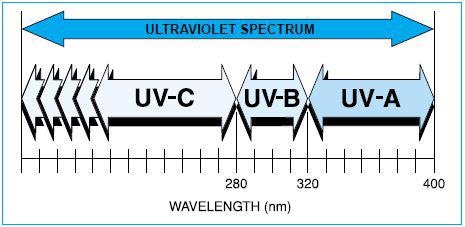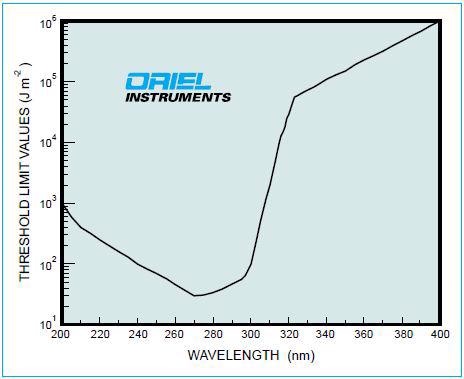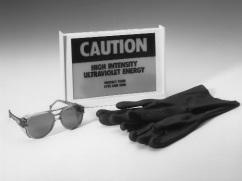Apr 7 2014
Ultraviolet radiation is an electromagnetic radiation in the wavelength interval between 10 and 400nm (Figure 1). Photobiologists apply the term UVA for 320-400nm, UVB for 280-320nm, and UVC for wavelengths to 280nm. However, there is disagreement on the 280nm region. Radiation below 180nm is called vacuum UV.

Figure 1. The Ultraviolet Spectrum
UV Radiation from Oriel Lamp Sources
Oriel deuterium and arc lamp sources, Flood Exposure Sources, Solar Simulators, and spectral calibration lamps generate ultraviolet with wavelengths down to 180nm and below, based on the lamp and its the envelope material. Oriel Quartz Tungsten Halogen Sources generate some radiation down to 220nm. The UV intensity levels from certain sources may be greater than those from the sun, and may have shorter wavelengths.
Exposure Hazards
UV radiation exposure even for shorter duration can be harmful. The level of damage relies on the exposure time, the wavelength, the radiation intensity, and the sensitivity of the individual to UV. Exposure to UVC and UVB results in sunburn and pigmentation. Long term exposure causes premature aging). There is a strong connection between skin cancer and wavelength below 320nm. Figure 2 depicts threshold limit values for occupational exposure to ultraviolet radiation in an 8 hour period. These values for exposure of the eye or the skin are applicable to UV rays from arcs, gas and vapor discharges, fluorescent and incandescent sources, and solar radiation, but are not applicable to UV lasers.

Figure 2. Threshold limit values for occupational exposure to ultraviolet radiation in an 8 hour period.
Corneal absorption of UVB and UVC may result in conjunctivitis and a corneal inflammation termed as photo keratitis. Oriel Instruments’ innocuous pencil style mercury calibration lamps can cause conjunctivitis. Prolonged exposure to longer ultraviolet radiation, especially UVA, may lead to the formation of cataracts in the eye lens and can cause blue blindness.
UV Safety Precautions
Avoiding exposure to UV source is the simplest safety precaution. This can be achieved with filters and lenses offered by Oriel Instruments. The following are the safety measures to alleviate UV risks:
- Use enclosed beam paths wherever possible
- Use a manual or electronic shutter to close the beam when the source is idle
- Never look directly at the beam
- Restrict access to regions using UV sources
- Cover arms and neck and limit exposure time
- Wear protective eyewear and gloves
- Post warning signs at the entrance to areas using UV sources
Safety Regulations
The U.S. National Institute for Occupational Safety and Health (NIOSH) recommends that UV exposure needs to be limited and controlled in the work place. Although admissible exposure limits are available, they are not applicable to photosensitive individuals or people exposed to photosensitizers. For exposure times longer than 1000s, the total intensity from 320 to 400nm is limited to 10 W m-2. The energy density is limited to 104 J m-2 for shorter exposure times.
Prolonged exposure to intense ultraviolet radiation can be harmful, especially to the eyes. Even shorter exposure to UV radiation can result in reddening and burning of the skin and eyes. Oriel Nitrogen Laser and Arc Lamp and Deuterium Sources emit high intensity, harmful ultraviolet radiation. QTH sources and spectral calibration lamps also emit UV radiation. Hence, it is necessary to wear protective eyewear and clothing.
UV Safety Goggles and Spectacles
Oriel eyewear safeguards users from the intense UV output of Oriel light sources without reducing visibility (Figure 3). Spectacles and goggles are the two frame styles offered by Oriel Instruments. They are made of hard, durable, non-UV transmissive plastic close fitting side shields to protect the eyes from UV radiation. The recessed lenses are scratch resistant. The goggles feature a soft, flexible frame with adjustable head band. Screened ventilation ports reduce moisture build-up. They offer visibility better than the spectacles. These goggles may be worn over prescription glasses with 50mm lenses.

Figure 3. Transmittance of the 49125 UV Safety Spectacles and 49126 Safety Goggles
Protective Gloves
Hands handling the fixtures in the beam are more risk to UV radiation. Operators can protect their hands and have the flexibility required for handling small components using Oriel gloves. The gloves are made of black neoprene with a soft, cotton flock lining, which absorbs perspiration for easy wearing and removal.
UV and Laser Radiation Warning Signs
Oriel Instruments provides lighted signs and adhesive backed signs with ultraviolet and laser radiation warnings. Lighted warning signs are large, highly visible signs employed in areas involving intense UV exposure or laser radiation. They can accommodate many different mounting configurations. An injection-molded thermoplastic white frame and steel face hold the legends, which include One "CAUTION" UV sign; Two "CAUTION" laser signs; and Three "DANGER" laser signs. Lighted warning signs also include a 6 ft. (1.8 m) power cord, two extended life 12W lamps, and a 25 ft. (7.6 m) interlock cable.
These signs can be operated in one of three modes: flashing light, continuous light, and flashing light with an audible beep. A built-in potentiometer controls the ‘beep’ volume. All three modes are switched by the interlock contact closure. Adhesive backed signs are made from flexible mylar with a peel-off adhesive back. These are the legends from the illuminated sign. Figure 4 shows 49125 UV Safety Spectacles, 49121 Protective Gloves, and 79004 Lighted Warning Sign.

Figure 4. 49125 UV Safety Spectacles, 49121 Protective Gloves, and 79004 Lighted Warning Sign
About Oriel Instruments
Oriel Instruments, a Newport Corporation brand, was founded in 1969 and quickly gained a reputation as an innovative supplier of products for the making and measuring of light. Today, the Oriel brand represents leading instruments, such as light sources covering a broad range from UV to IR, pulsed or continuous, and low to high power.
Oriel also offers monochromators and spectrographs as well as flexible FT-IR spectrometers, which make it easy for users across many industries to build instruments for specific applications. Oriel is also a leader in the area of Photovoltaics with its offering of solar simulators that allow you to simulate hours of solar radiation in minutes. Oriel continues to bring innovative products and solutions to Newport customers around the world.

This information has been sourced, reviewed and adapted from materials provided by Oriel Instruments.
For more information on this source, please visit Oriel Instruments.